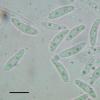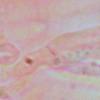
12-11-2025 09:25
 Viktorie Halasu
Viktorie Halasu
Hello, I need help with a pale terrestric Pseudom

11-11-2025 20:16
Bohan JiaHi, lastly I have found these tiny yellow decayin

09-11-2025 13:20
Hello.A tiny ascomycete, appearing as erupting gra

08-11-2025 00:29
 Francois Guay
Francois Guay
I found this species in Quebec, Canada, on herbace
Hymenoscyphus
Nicolas VAN VOOREN,
28-09-2019 10:32
 Hello.
Hello.Here is a Hymenoscyphus growing on a small dead branch (hardwood), in a wet place.
Excipulum of textura subprismatica, becoming ± a t. subglobulosa at the base, mixed with clavate cells.
Paraphyses without VBs.
Asci without crozier, IKI+ (bb)
Spores 13-16 × (3.2) 3.5-4 µm
Any suggestion?
Hans-Otto Baral,
28-09-2019 10:39

Re : Hymenoscyphus
Hi Nicolas
with this spore characters I the absence of VBs and croziers sounds strange. Can you give photos of them? The apothecia are completely stalkless? What diameter?
with this spore characters I the absence of VBs and croziers sounds strange. Can you give photos of them? The apothecia are completely stalkless? What diameter?
Nicolas VAN VOOREN,
28-09-2019 10:42

Re : Hymenoscyphus
Thanks Zotto for your reply. I'm going to make a new prep, now the specimens are dried.
Apothecia are very short-stalked, reaching 1.5 mm diam.
Apothecia are very short-stalked, reaching 1.5 mm diam.
Hans-Otto Baral,
28-09-2019 15:36

Re : Hymenoscyphus
No doubt! That could point to Ph. fulvidulum which is usually dark-coloured, but when there were no VBs in the living paraphyses, then this is ruled out.



